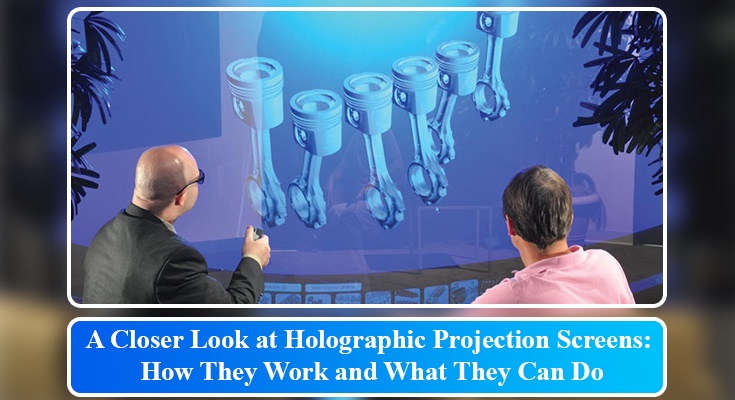Holographic projection screens, representing a breakthrough in visual technology, have defied the constraints imposed by traditional displays. Their emergence marks a significant stride towards more immersive and dynamic visual experiences. These screens redefine the ways we perceive and interact with digital content, unlocking new possibilities in various fields.
Holographic projection screens offer a unique and immersive experience by creating three-dimensional illusions that captivate audiences. In this article, we'll unravel the inner workings of holographic projection screens and uncover their wide array of applications.
Understanding Holography
At the core of holographic projection screens lies the concept of holography. In contrast to traditional displays that depend on two-dimensional images, holography records and reconstructs light patterns to create the illusion of three-dimensional objects.
This innovative technology enhances visual experiences by adding depth and realism to the projected images This technique involves capturing interference patterns created by light interacting with the subject and then projecting them onto a transparent surface.
The Holographic Process:
The Holographic projection screens
- Light Source Illumination: The process commences with a light source, typically a laser, illuminating the subject intended for capture.
- Interference Pattern Creation: The illuminated light interacts with the object, forming intricate interference patterns.
- Recording on Photosensitive Material: These interference patterns are recorded on photosensitive material, commonly holographic film, capturing detailed information.
- Hologram Transfer: The resulting hologram is then transferred onto a transparent screen, serving as the canvas for projecting the holographic image.
- Projection of Holographic Image: The transparent screen, now containing the holographic information, acts as a medium for projecting the three-dimensional holographic image.
Holographic Projection Screen Features
- Diffracting Light for 3D Illusions: Holographic projection screens possess a distinctive capability to diffract light in various directions, setting them apart.
- Formation of Virtual Image: Through this process, a virtual image is formed, giving the illusion of three-dimensional representation.
- Viewer Experience: Viewers then encounter depth and dimensionality, contributing to a lifelike and immersive portrayal of the subject.
The Multifaceted Impact of Holographic Projection Screens
- Revolutionizing Advertising: Holographic projection screens redefine product showcases, providing a dynamic and attention-grabbing platform for advertisers.
- Enhancing Education: In the educational sector, holographic displays play a pivotal role in bringing complex subjects to life. They offer enhanced learning experiences, making information more engaging and understandable for students.
- Medical Marvels: Medical professionals utilize holographic projection screens for detailed anatomical visualizations, introducing a new dimension to surgical planning and training. This advanced technology enhances the understanding of complex medical procedures and contributes to more effective training for healthcare professionals.
- Transforming Entertainment: The entertainment industry is undergoing a paradigm shift as holographic displays add interactivity to live performances. Iconic musicians are resurrected on stage through holographic renditions, captivating audiences with a blend of nostalgia and innovation.
The Intersection of Innovation and Imagination: What Lies Ahead
- The intersection of Innovation and Imagination: The future of holographic projection screens is a captivating journey at the crossroads of innovation and imagination. It brings groundbreaking advancements that redefine our visual experiences.
- Evolution of Technology: As technology evolves, the integration of augmented reality (AR) and artificial intelligence (AI) emerges as a key catalyst. It promises to elevate the interactive capabilities of holographic screens.
- Diversification of Applications: The convergence of AR, AI, and holographic technology expands the scope of applications into diverse realms. It includes gaming, virtual collaboration, and immersive simulations, unlocking new possibilities for user engagement.
- Synergy of Innovative Technologies: Innovative synergy transforms holographic potential into lifelike, dynamic experiences.
Conclusion:
Delving into the intricacies of holographic projection screens unveils a realm of technological marvel that goes beyond conventional visual displays.
Holographic projection screens are not merely tools; they serve as gateways to a future where information is presented in captivating, three-dimensional forms. Exploring the boundless possibilities, holographic projection screens promise an exciting journey at the intersection of innovation and imagination. Take your Holographic Stage Technology to the next level with Vision 3d. Contact Vision 3D to explore the product.


No comments yet